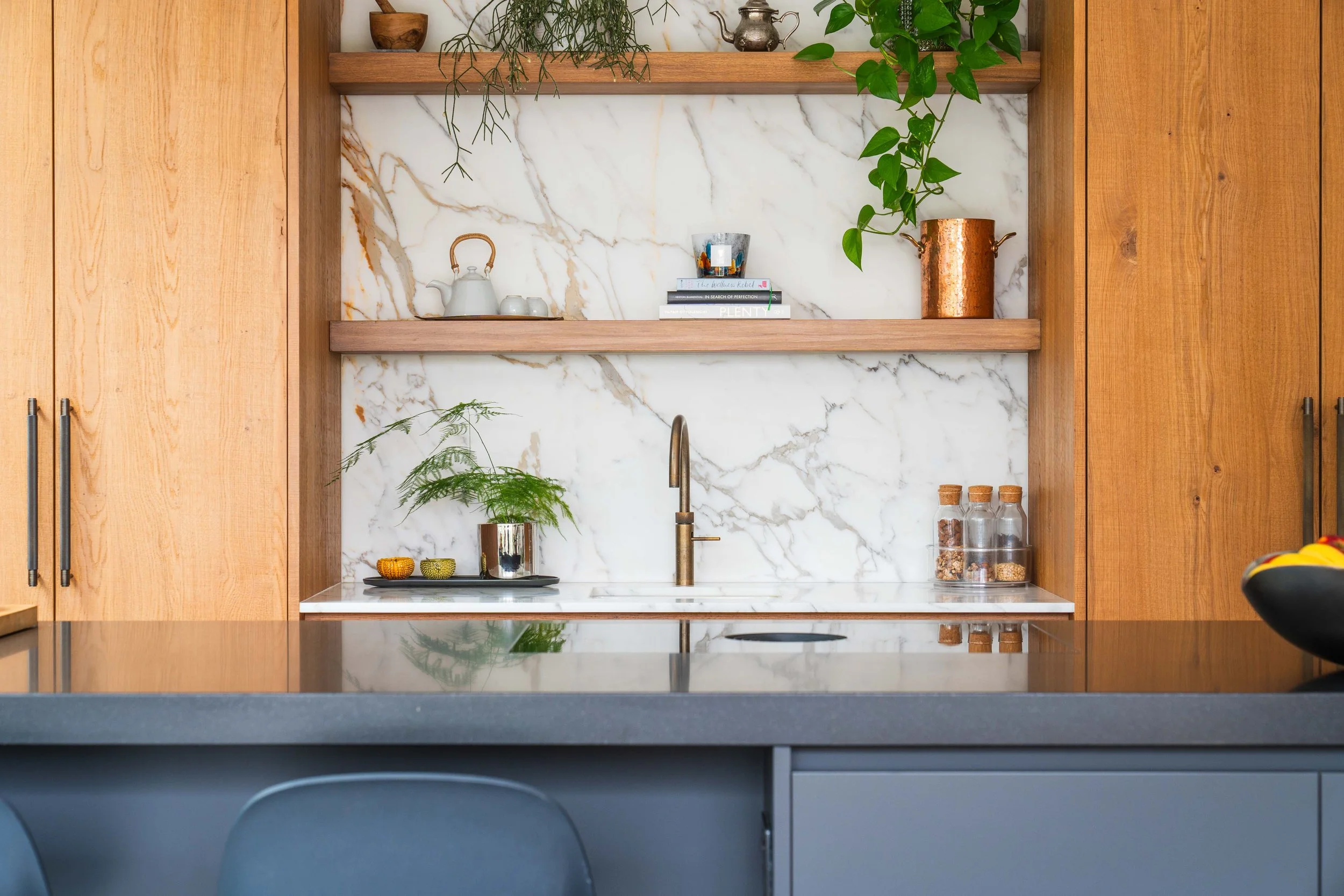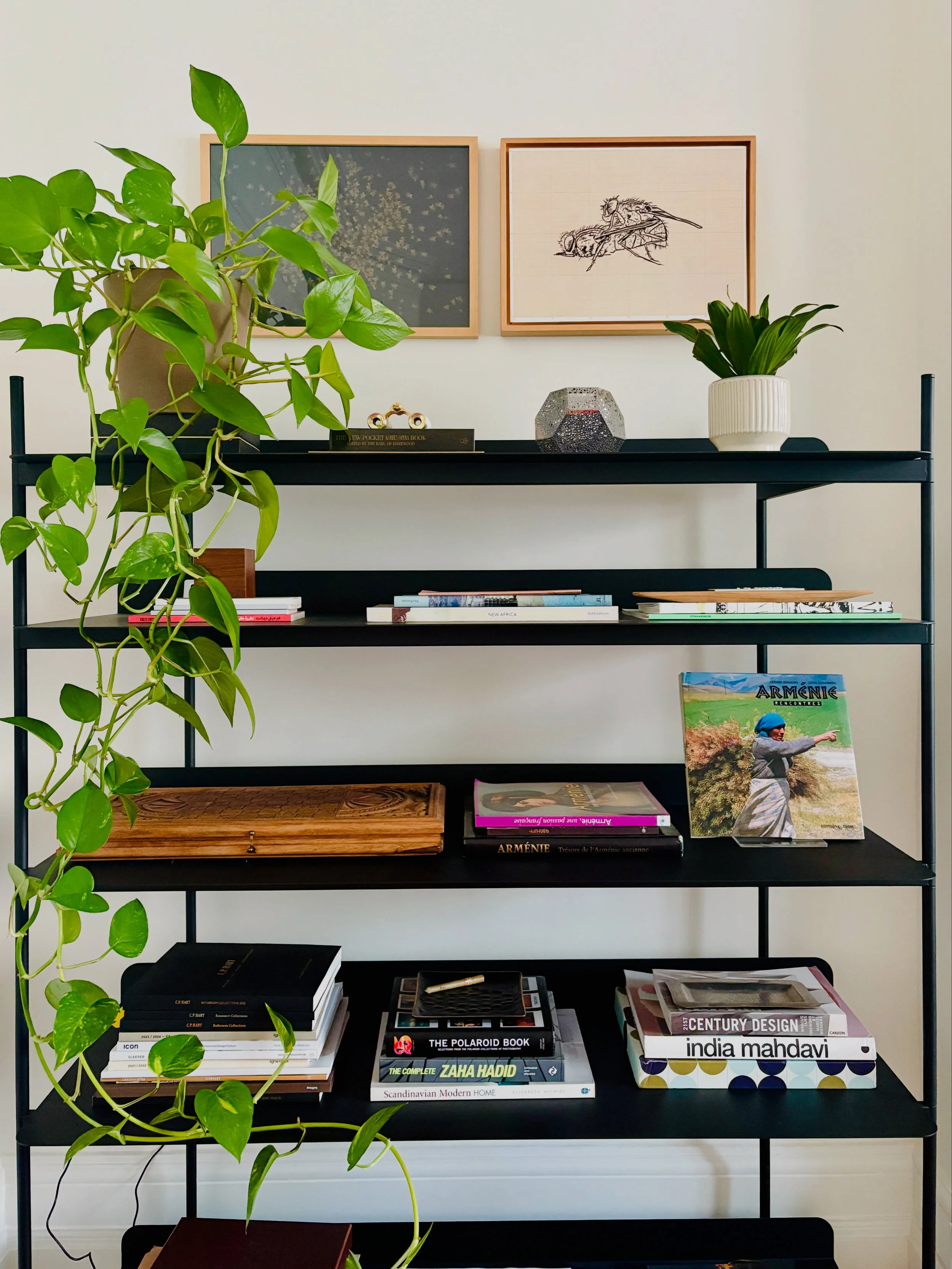The Powerful Impact of Designing With Plants
Have you ever walked into a beautifully decorated room (great furniture, stunning colours, striking artwork) and still felt something was missing? That subtle sense of coldness or emptiness?
Here’s the secret: no room feels complete without plants. Yes, that’s right. Every single room in a home needs greenery to feel alive. Plants add warmth, depth, and texture in the same way we layer fabrics, finishes, and colors in design. They don’t just decorate a room. Plants transform its atmosphere.
Open shelves in a kitchen, styled with plants
Beyond the pleasing aesthetics, medical studies continue to highlight the therapeutic impact of plants on mood and well-being. They reduce stress, purify the air, and create an inviting energy that no other accessory can replicate.
And yet, I often hear the classic excuse: “I can’t do plants, I don’t have a green thumb.” The essential step is simply to get started. And one golden rule in my book: absolutely no fake plants. They collect dust, never age gracefully, and can’t give your space the energy or health benefits that real plants bring.
Design principles: decorating with plants
Think of plants as textures. Just like combining rough wood with soft textiles, mixing plants of different heights, leaf shapes, and textures brings layers of visual interest.
Consider light and humidity. Plants are living creatures and they need the right conditions to thrive. Avoid shady corners, and remember that most plants prefer bright, indirect light (near windows, but not in harsh sun). Bathrooms are often perfect for humidity-loving varieties.
Soil matters. A well-draining mix is key. Try 70% peat free all-purpose compost with 30% perlite for an easy, reliable recipe.
Propagate for charm. Small glass jars with a few leaves rooting in water can look just as stylish as finished plants. They add life, movement, and a sense of “work in progress” to your space.
Start simple. Don’t overwhelm yourself. Even one thriving plant can shift the energy of a space.
Avocado propagation bottles in a sunny bathroom
Quick tip: In an instant, Google Lens search can give you care instructions for almost any plant!
Beginner-Friendly “Unkillable” Plants
If you’re new to houseplants, start with these hardy varieties that suit almost any light conditions:
Devil’s Ivy (Pothos) – Beautiful trailing leaves that soften shelves or hanging pots.
ZZ Plant (Zamioculcas zamiifolia) – Architectural, glossy leaves, slow-growing, very forgiving.
Snake Plant – Similar toughness to ZZ, with striking vertical lines.
Dracaena – Perfect for a taller, tree-like effect without the maintenance stress.
Simple shelf styled with a dramatic Devil’s Ivy and a smaller Palm plant
For the More Adventurous
Once you’re comfortable, try experimenting with statement plants that make a bold impact:
Fiddle Leaf Fig – A design favorite with its dramatic large leaves, but a little finicky with light.
Monstera Deliciosa – Iconic split leaves, thrives in humidity but prone to pests.
Asparagus Fern – Delicate, airy fronds that add softness (great for bathrooms).
Ficus Benjamina – A graceful, tree-like structure for moderate light.
Rubber Plant – Glossy leaves, striking form, and fairly easy to manage.
Chinese Money Plant – Playful round leaves, great conversation piece.
Final Thoughts
Designing with plants isn’t about perfection. It’s about experimenting, learning, and letting your home evolve. Whether it’s a cascading pothos on a bookshelf, a majestic fiddle leaf in the corner, or a cluster of jars with new cuttings on a windowsill, plants have the power to make spaces not just look beautiful, but feel beautiful too.
So, green thumb or not, start small. Add one plant to your living room today. You’ll be amazed at how quickly it changes the mood.
Winter setup, plants grouped together in the sunniest spot of the house, in Dulwich Village








